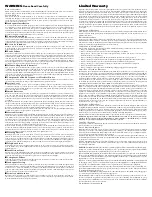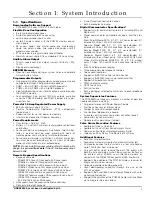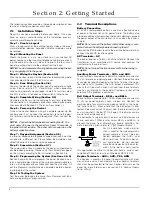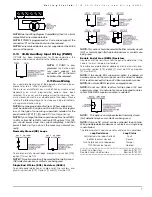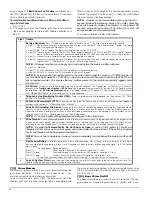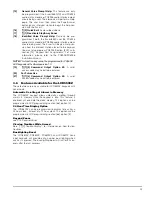
G e t t i n g S t a r t e d :
2 . 3 W i r e R o u t i n g f o r P o w e r & N o n - P o w e r L i m i t e d
5
Programmable Output Terminals – PGM1 and PGM2
Each PGM output is designed so that when activated by the
panel, the terminal will switch to ground
PGM1 can sink up to 50mA of
current. Connect the positive
side of the LED or buzzer to
AUX+, the negative side to
PGM1. PGM2 operates similarly
to PGM1. However, PGM2 can
sink up to 300mA of current. If
more than 300mA of current are
required, a relay must be used.
NOTE:
For the 50/50 version of
this panel, PGM2 can sink up to
50mA. If more current is
required, a relay must be used.
Please study PGM wiring in the
accompanying diagram. For a
list of the programmable output options, please see section
5.11
“PGM Output Options”
.
Zone Input Terminals – Z1 to Z6
Each detection device must be connected to a zone on the
control panel. We suggest that one detection device be con-
nected to each zone; wiring multiple detection devices to a
single zone, however, is possible. For zone wiring specifics,
please see section 2.11
“Zone Wiring”
.
Telephone Connection Terminals – TIP, RING, T-1, R-1
If a telephone line is required for central station communica-
tion or downloading, connect an RJ-31X telephone jack in the
following manner:
Connect the PC1555MX and modules which use the tele-
phone line(s) in the following order:
For example, if you are installing a PC1555MX with a
LINKS1000 and a PC5928 Intercom module, connect the
incoming line to the LINKS1000, then from the LINKS1000 to
the PC1555MX, then from the PC1555MX to the PC5928 Inter-
com and then from the PC5928 to the house telephones.
NOTE:
Please ensure that all plugs and jacks meet the dimen-
sion, tolerance and metallic plating requirements of 47 C.F.R.
Part 68, SubPart F. For proper operation, no other telephone
equipment should be connected between the control panel and
the telephone company facilities. Do not connect the alarm
panel communicator to telephone lines intended for use with a
fax machine. These lines may incorporate a voice filter which
disconnects the line if anything other than fax signals is
detected, resulting in incomplete transmissions.
2.3 Wire Routing for Power & Non-Power
Limited
All wiring entry points are designated by the arrows. All cir-
cuits are classified UL installation power limited except for the
battery leads which are not power limited.
A minimum ¼” (6.4mm) separation must be maintained at all
points between power limited and non-power limited wiring
and connections.
NOTE:
Wire entry for power limited wiring must be separated
by a different entry access from non-power limited wiring.
2.4
Keybus Operation & Wiring
The keybus is used by the panel to communicate with all con-
nected modules and vice versa. The red (AUX+) and black
(AUX-) terminals are used to provide power, while the yellow
(YEL) and green (GRN) terminals are clock and data respec-
tively.
NOTE:
The four Keybus terminals of the panel must be con-
nected to the four Keybus terminals or wires of all modules.
The following restrictions apply to keybus wiring:
•
Keybus should be run in minimum 22-gauge quad
(0.5mm); two pair twisted is preferred.
•
The modules should be home-run to the panel but can be
connected in series or T-tapped.
•
Any module can be connected anywhere along the key-
bus. You do not need to run a separate keybus wire for
keypads, etc.
•
No module can be more than 1,000'/305m (in wire length)
from the panel.
•
Shielded wire should not be used.
Example of Keybus Wiring
NOTE:
Module (A) is cor-
rectly wired within 1,000'/
305m from the panel. Module
(B) is correctly wired within
1,000'/305m of wire from the
panel. Module (C) is NOT
wired correctly as it is further
than 1,000'/305m from the
panel, in wire distance.
2.5
Current Ratings – Modules &
Accessories
In order for the PC1555MX system to operate properly, the
power output capabilities of the main control and the expan-
Keybus
NOTE:
A minimum 1/4" (6.4mm) separation
must be maintained at all points between
power limited and non-power limited wiring
and connections.


